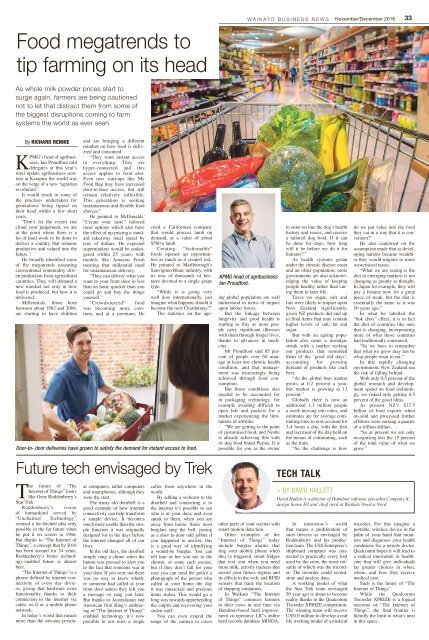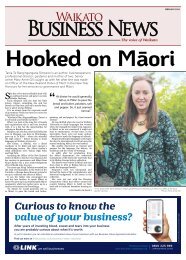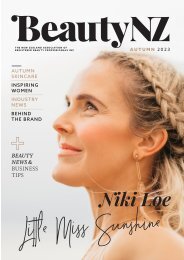Waikato Business News November/December 2016
Waikato Business News has for a quarter of a century been the voice of the region’s business community, a business community with a very real commitment to innovation and an ethos of co-operation.
Waikato Business News has for a quarter of a century been the
voice of the region’s business community, a business community
with a very real commitment to innovation and an ethos of
co-operation.
Create successful ePaper yourself
Turn your PDF publications into a flip-book with our unique Google optimized e-Paper software.
WAIKATO BUSINESS NEWS <strong>November</strong>/<strong>December</strong> <strong>2016</strong> 33<br />
Food megatrends to<br />
tip farming on its head<br />
As whole milk powder prices start to<br />
surge again, farmers are being cautioned<br />
not to let that distract them from some of<br />
the biggest disruptions coming to farm<br />
systems the world as ever seen.<br />
By RICHARD RENNIE<br />
KPMG’s head of agribusiness,<br />
Ian Proudfoot told<br />
delegates at this year’s<br />
rural update agribusiness seminar<br />
at Karapiro the world was<br />
on the verge of a new “agrarian<br />
revolution”.<br />
It would result in some of<br />
the practises undertaken for<br />
generations being tipped on<br />
their head within a few short<br />
years.<br />
“Don’t let the recent rise<br />
cloud your judgement, we are<br />
at the point where there is a<br />
lot of hard work to be done to<br />
deliver a country that remains<br />
productive and valued into the<br />
future.”<br />
He broadly identified some<br />
of the megatrends unseating<br />
conventional commodity driven<br />
production from agricultural<br />
countries. They will demand a<br />
new mindset not only in how<br />
food is produced, but how it is<br />
delivered.<br />
Millennials, those born<br />
between about 1982 and 2004,<br />
are starting to have children<br />
and are bringing a different<br />
mindset on how food is delivered<br />
and consumed.<br />
“They want instant access<br />
to everything. They are<br />
hyper-connected and this<br />
access applies to food also.<br />
Even new start-ups like My<br />
Food Bag may have increased<br />
door-to-door access, but still<br />
remain relatively inflexible.<br />
This generation is seeking<br />
instantaneous and flexible food<br />
choices.”<br />
He pointed to McDonalds’<br />
“Create your taste” tailored<br />
meal options which also have<br />
the effect of up-pricing a standard<br />
takeaway meal spend by<br />
tens of dollars. He expected<br />
supermarkets would be endangered<br />
within 25 years, with<br />
models like Amazon Fresh<br />
meeting that millennial need<br />
for instantaneous delivery.<br />
“They can deliver what you<br />
want to your front door in less<br />
than an hour, quicker than you<br />
could go and buy the things<br />
yourself.”<br />
“Crowdsourced” food<br />
was becoming more common,<br />
and at a premium. He<br />
cited a Californian company<br />
that would process lamb on<br />
demand, at a value of about<br />
$500 a lamb.<br />
Door-to- door deliveries have grown to satisfy the demand for instant access to food.<br />
Future tech envisaged by Trek<br />
The future of “The<br />
Internet of Things” looks<br />
like Gene Roddenberry’s<br />
Star Trek.<br />
Roddenberry’s vision<br />
of humankind served by<br />
“Unchained Technology”<br />
seemed a far-fetched idea only<br />
possible in the far future when<br />
he put it on screen in 1966.<br />
But thanks to “The Internet of<br />
Things”, a concept that by <strong>2016</strong><br />
has been around for 34 years,<br />
Roddenberry’s better technology-enabled<br />
future is almost<br />
here.<br />
“The Internet of Things” is a<br />
phrase defined by internet connectivity<br />
of every day devices,<br />
giving that hardware extra<br />
functionality thanks to their<br />
connection to the internet via<br />
cable, wi-fi or a mobile phone<br />
network.<br />
In today’s world that means<br />
more than the obvious personal<br />
computers, tablet computers<br />
and smartphones, although they<br />
were the start.<br />
The trusty old doorbell is a<br />
good example of how internet<br />
connectivity can help transform<br />
a simple device. It becomes<br />
much more usable than the simple<br />
function it was originally<br />
designed for in the days before<br />
the internet changed all of our<br />
lives.<br />
In the old days, the doorbell<br />
simply rang a chime when the<br />
button was pressed to alert you<br />
to the fact that someone was at<br />
your door. If you were out there<br />
was no way to know whether<br />
someone had called at your<br />
front door unless they left you<br />
a message or rang you later.<br />
But thanks to Australasian and<br />
American firm Ring’s embracing<br />
of “The Internet of Things”<br />
enabled technology it’s now<br />
possible to not miss a single<br />
caller from anywhere in the<br />
world.<br />
By adding a webcam to the<br />
doorbell and connecting it to<br />
the internet it’s possible to see<br />
who is at your door, and even<br />
speak to them, when you are<br />
away from home. Since most<br />
burglars ring the bell, posing<br />
as a door to door odd jobber if<br />
you happened to answer, this<br />
is a good way of identifying<br />
a would-be burglar. You can<br />
tell him or her you are in the<br />
shower, or some such excuse,<br />
but if they don’t fall for your<br />
ruse you can send the police a<br />
photograph of the person who<br />
called at your home the day<br />
it was ransacked and precious<br />
items stolen. This would go a<br />
long way towards apprehending<br />
the culprit and recovering your<br />
stolen stuff.<br />
You can even extend the<br />
range of the camera to cover<br />
KPMG head of agribusiness<br />
Ian Proudfoot.<br />
Creating “fashionable”<br />
foods opened up opportunities<br />
as much as it created risk.<br />
He pointed to Marlborough’s<br />
Sauvignon Blanc industry, with<br />
its tens of thousands of hectares<br />
devoted to a single grape<br />
type.<br />
“While it is going very<br />
well now internationally, just<br />
imagine what happens should it<br />
become the next Chardonnay?”<br />
The statistics on the ageing<br />
global population are well<br />
understood in terms of impact<br />
upon labour forces.<br />
But the linkage between<br />
longevity and good health is<br />
starting to fray as more people<br />
carry significant illnesses<br />
with them through longer lives,<br />
thanks to advances in medicine.<br />
Mr Proudfoot said 85 percent<br />
of people over 60 manage<br />
at least one chronic health<br />
condition, and that management<br />
was increasingly being<br />
achieved through food consumption.<br />
But those conditions also<br />
needed to be accounted for<br />
in packaging technology, for<br />
example avoiding difficult to<br />
open lids and packets for a<br />
market experiencing the limitations<br />
of arthritis.<br />
“We are getting to the point<br />
of customised food, and Nestle<br />
is already achieving this with<br />
its dog food brand Purina. It is<br />
possible for you as the owner<br />
other parts of your section with<br />
smart motion detection.<br />
Other examples of the<br />
“Internet of Things” today<br />
include burglar alarms that<br />
ring your mobile phone when<br />
they’re triggered, smart fridges<br />
that text you when you need<br />
more milk, activity trackers that<br />
record your fitness regime and<br />
its effects to the web, and RFID<br />
sensors that track the location<br />
of shipping containers.<br />
In <strong>Waikato</strong> “The Internet<br />
of Things” connects farmers<br />
to their cows in real time via<br />
Hamilton-based herd improvement<br />
co-operative LIC's online<br />
herd records database MINDA.<br />
to enter on line the dog’s health<br />
history and issues, and receive<br />
a tailored dog food. If it can<br />
be done for dogs, how long<br />
will it be before we do it for<br />
humans?”<br />
As health systems groan<br />
under the chronic disease onset<br />
and an older population, more<br />
governments are also acknowledging<br />
the value of keeping<br />
people healthy rather than curing<br />
them in later life.<br />
Taxes on sugar, salt and<br />
fats were likely to impact upon<br />
New Zealand significantly,<br />
given NZ products did end up<br />
in final items that may contain<br />
higher levels of salt, fat and<br />
sugar.<br />
But with an ageing population<br />
also came a nostalgic<br />
streak with a market seeking<br />
out products that reminded<br />
them of the ‘good old days’,<br />
accounting for growing<br />
demand of products like craft<br />
beer.<br />
“As the global beer market<br />
grows at 0.2 percent a year,<br />
this market is growing at 13<br />
percent.”<br />
Globally there is now an<br />
additional 1.3 million people<br />
a week moving into cities, and<br />
estimates are for average commuting<br />
time to now account for<br />
3-4 hours a day, with the first<br />
and last meal of the day held on<br />
the means of commuting, such<br />
as the train.<br />
“So the challenge is how<br />
TECH TALK<br />
> BY DAVID HALLETT<br />
do we put value into the food<br />
they eat in a way that it is convenient?”<br />
He also cautioned on the<br />
assumption made that as developing<br />
nations became wealthier<br />
they would migrate to more<br />
westernised tastes.<br />
“What we are seeing is the<br />
diet in emerging markets is not<br />
changing as greatly as thought.<br />
In Japan for example, they will<br />
pay a fortune now for a great<br />
piece of steak, but the diet is<br />
essentially the same as it was<br />
50 years ago.”<br />
In what he labelled the<br />
“bok choy” effect, it is in fact<br />
the diet of countries like ours<br />
that is changing, incorporating<br />
more of what those countries<br />
had traditionally consumed.<br />
“So we have to remember<br />
that what we grow may not be<br />
what people want to eat.”<br />
In this rapidly changing<br />
environment, New Zealand ran<br />
the risk of falling behind.<br />
With only 0.5 percent of the<br />
global research and development<br />
spend on food technology,<br />
we risked only getting 0.5<br />
percent of the good ideas.<br />
At present NZ’s $37.5<br />
billion of food exports when<br />
on-sold and processed further<br />
offshore were earning a quarter<br />
of a trillion dollars.<br />
“So at present we are only<br />
recognising less the 15 percent<br />
of the total value of what we<br />
grow.”<br />
David Hallett is a director of Hamilton software specialist Company-X,<br />
design house E9 and chief nerd at <strong>Waikato</strong> Need a Nerd.<br />
In tomorrow’s world<br />
that means a proliferation of<br />
such devices as envisaged by<br />
Roddenberry and his production<br />
team. The USS Enterprise’s<br />
shipboard computer was connected<br />
to practically every tool<br />
used by the crew, the most versatile<br />
of which was the tricorder.<br />
The tricorder could record,<br />
store and analyse data.<br />
A working model of what<br />
the Star Trek team envisaged<br />
50 year ago is about to become<br />
reality thanks to the Qualcomm<br />
Tricorder XPRIZE competition.<br />
The winning team will receive<br />
US$10 million to develop a real<br />
life working model of a medical<br />
tricorder. For this imagine a<br />
portable, wireless device in the<br />
palm of your hand that monitors<br />
and diagnoses your health<br />
conditions for a remote doctor.<br />
Qualcomm hopes it will lead to<br />
a radical innovation in healthcare<br />
that will give individuals<br />
far greater choices in when,<br />
where, and how they receive<br />
medical care.<br />
Such is the future of “The<br />
Internet of Things”.<br />
While the Qualcomm<br />
Tricroder XPRIZE is a logical<br />
outcome of “The Internet of<br />
Things”, the final frontier is<br />
literally the limit to what’s next<br />
in this space.


















